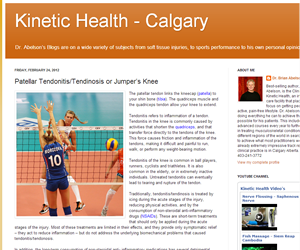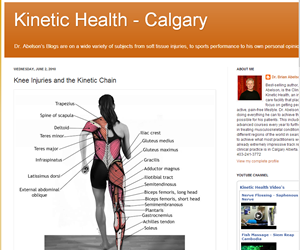Patellar Tendonitis or Jumper’s Knee

Tendonitis refers to inflammation of a tendon.
Tendonitis in the knee is commonly caused by activities that shorten the quadriceps, and that transfer force directly to the tendons of the knee. This force causes friction and inflammation of the tendons, making it difficult and painful to run, walk, or perform any weight-bearing motion.
Tendonitis of the knee is common in ball players, runners, cyclists, dancers, and triathletes. It is also common in the elderly, or in extremely inactive individuals. Untreated tendonitis can eventually lead to tearing and rupture of the tendon.
Resolving Patellar Tendonitis
At Kinetic Health, we successfully resolve Patellar Tendonitis by using a combination of Active Release Techniques and a carefully selected set of functional exercises. Click on each of the following tabs for more information about how we work with you to heal your injury.
- About the Patellar Tendon
- Traditional Treatments
- Treating with ART
- Exercise Books
- Exercise Videos
- Exercise Blogs
About the Patellar Tendon
The patellar tendon links the patella (kneecap) to the tibia (shin bone) and allows the knee to extend.
Restrictions in the Quadriceps muscles (rectus femoris, vastus lateralis, vastus medialis,and vastus intermedius) creates tension and inflammation in the patellar tendon. This must be released for any successful resolution of the Patellar Tendonitis.
Traditional Treatments for Tendonitis
Traditionally, tendonitis/tendinosis is treated by icing during the acute stages of the injury, reducing physical activities, and by 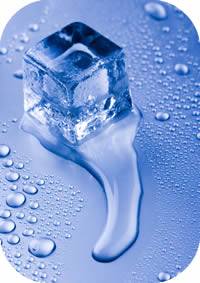 the consumption of non-steroidal anti-inflammatory drugs (NSAIDs). These are short-term treatments that should only be applied during the acute stages of the injury.
the consumption of non-steroidal anti-inflammatory drugs (NSAIDs). These are short-term treatments that should only be applied during the acute stages of the injury.
Most of these treatments are limited in their effects, and they provide only symptomatic relief, they act to reduce inflammation, but do not address the underlying biomechanical problems that caused the tendonitis/tendonosis.
In addition, the long-term consumption of non-steroidal anti- inflammatory medications has several detrimental side-effects including gastrointestinal problems, ulcerations, and internal bleeding.
Treating Patellar Tendonitis with ART
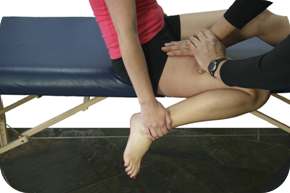 Patellar Tendonitis, or Jumper’s Knee, usually responds extremely well to ART treatments. The pain caused by Patellar Tendonitis is usually felt between the kneecap (patella) and its attachment point on the shin bone (tibial tuberosity of the tibia). Essentially, the entire knee capsule must be evaluated and any restrictions that are found need to be removed.
Patellar Tendonitis, or Jumper’s Knee, usually responds extremely well to ART treatments. The pain caused by Patellar Tendonitis is usually felt between the kneecap (patella) and its attachment point on the shin bone (tibial tuberosity of the tibia). Essentially, the entire knee capsule must be evaluated and any restrictions that are found need to be removed.
It is equally important to remove any restrictions in the quadriceps muscle since muscle fibres from the quadriceps combine at the knee to form the patellar tendon.
Exercises to Help you Heal
Kinetic Health provides a number of excellent resources that can help you to resolve your knee injuries.
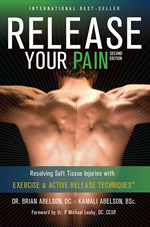 Release Your Pain: 2nd Edition
Release Your Pain: 2nd Edition
Dr.Abelson’s international best-seller – Release Your Pain – provides a detailed description about the causes of Knee Injuries. It discusses means for resolving this condition, and provides specially selected exercises to help you begin the process of healing from this condition.
Visit our website at www.releaseyourbody.com to purchase your eBook or hard-copy.
Exercise Videos for Patellar Tendonitis
The following videos provide extra information about Jumper’s Knee or Patellar Tendonitis, its kinetic chain, as well as exercises to help resolve this condition. Click on the left and right arrows to scroll through these videos.
- One Leg Split Squat
- Click To PlayPlay Video
The one leg split squat or Bulgarian split squat is an excellent exercise for activating the glutes (external hip rotators). Key exercise in rehabing back, hip, knee, ankle and even foot injuries.
- Foam Roller – The Adductors
- Click To PlayPlay Video
A groin strain usually refers to a tearing of one of the adductor muscles. This foam roller exercise will help you release restrictions on the inside of your thigh from your knee to your groin.
- Foam Roller – The Quadriceps
- Click To PlayPlay Video
The quadriceps is a group of four muscles that run along the front of your thigh. This foam roller exercise helps to release restrictions in this group of muscles.
- Foam Roller – Glute & IT Band
- Click To PlayPlay Video
The foam roller is a great way to do a myofascial release of both the glutes and the IT band
- PNF – The Adductors
- Click To PlayPlay Video
PNF Stretching is a great way to release the adductor muscles. A common set of structures involved in knee pain, and lower extremity Injuries.
- PNF Stretching – The Abductors (IT Band, TFL, Glute Medius)
- Click To PlayPlay Video
PNF Stretching is a great way to release the abductor muscles. A common set of structures involved in hip, low back, knee pain, and lower extremity problems.
- PNF – Quadriceps
- Click To PlayPlay Video
PNF Stretching is a great way to release the quadriceps muscles. A common structure involved in knee pain, and lower extremity problems.
- PNF – Hamstring Stretch
- Click To PlayPlay Video
PNF Stretching is a great way to release the hamstring muscles. A common structures involved in low back pain, sciatica, knee pain, and lower extremity problems.
- Foam Roller Hamstrings
Related Blog Articles by Dr. Abelson
Click on the following blog article for additional information on Patellar Tendonitis.
Patellar Tendonitis or Jumper’s Knee
The patellar tendon links the kneecap (patella) to your shin bone (tibia). The quadriceps muscle and the quadriceps tendon allow your knee to extend.
Tendonitis refers to inflammation of a tendon. Tendonitis in the knee is commonly caused by activities that shorten the quadriceps, and that transfer force directly to the tendons of the knee. This force causes friction and inflammation of the tendons, making it difficult and painful to run, walk, or perform any weight-bearing motion.

